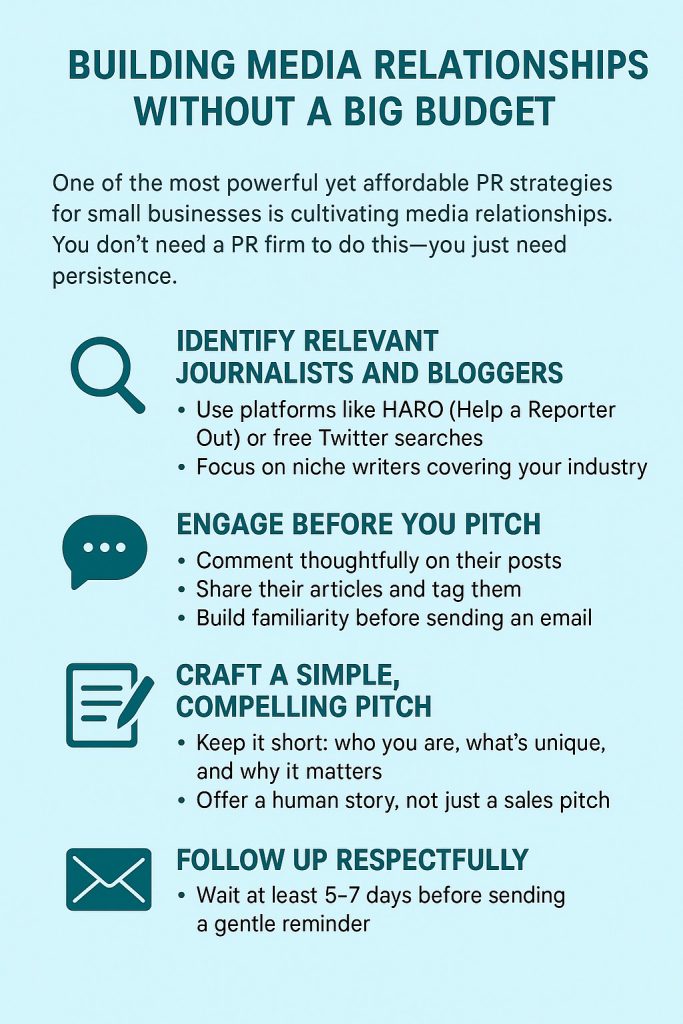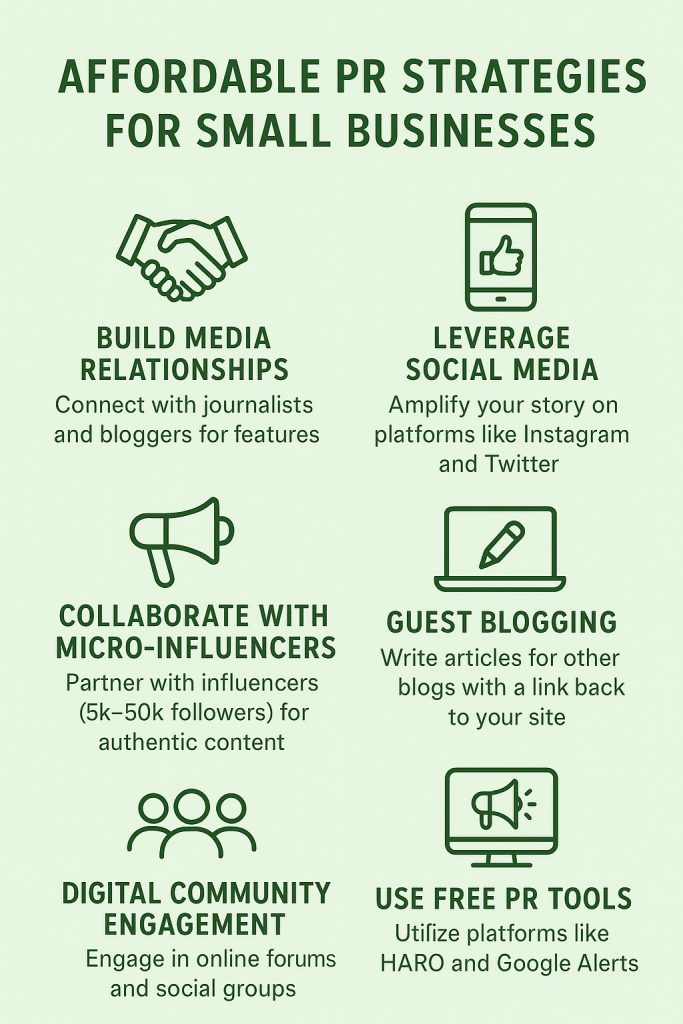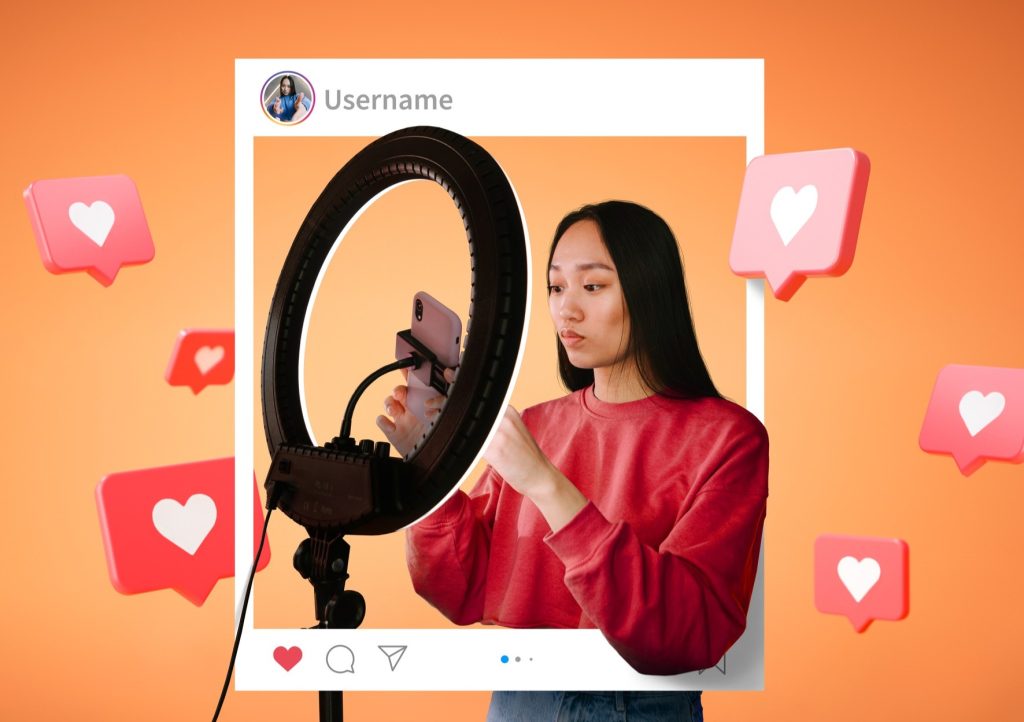Let’s imagine together, A young entrepreneur named Rina launched her online handmade jewelry store from her living room. She had no investors, no big marketing budget, and no professional PR team. Instead of spending thousands, she started small pitching her story to local lifestyle bloggers, sharing behind-the-scenes videos on Instagram, and sending personalized thank-you notes to every customer.
Within six months, one of her Instagram reels went viral, a local newspaper wrote about her brand, and a well-known fashion blogger featured her products. The result? Orders doubled, brand awareness skyrocketed, and she built a loyal online community all without breaking the bank.
Rina’s journey is proof that with the right affordable PR strategies for small businesses, it’s possible to capture attention, build credibility, and compete with larger brands. Now, let’s dive into how you can replicate her success.
Why PR Matters for Small Businesses in the Digital-First Economy
In today’s world, visibility equals opportunity. Small businesses no longer compete only with local shops they compete with global brands accessible in every customer’s pocket. Public Relations (PR) helps level the playing field by:
- Building Trust: Consumers are more likely to trust a story in the media than an ad.
- Boosting Awareness: Media coverage and social buzz put your business in front of audiences you may never reach otherwise.
- Driving Growth: Positive PR often leads to partnerships, investor interest, and higher sales.
- Creating Authority: Thought leadership pieces and interviews establish your credibility in your industry.
PR isn’t about expensive press releases anymore. It’s about strategic storytelling, connection, and consistency. For small businesses, that means being smart, resourceful, and personal.
Building Media Relationships Without a Big Budget
One of the most effective and budget-friendly PR strategies for small businesses is building strong media relationships. You don’t need an expensive PR Agency just consistent effort and genuine communication. Start by identifying local journalists, bloggers, and influencers in your industry. Follow their work, engage with their content, and offer valuable story ideas or expert insights. Focus on creating mutually beneficial connections rather than pushing sales. Over time, your persistence can lead to valuable media coverage, boosting your brand’s visibility and credibility.
For small businesses, mastering this DIY PR approach can lead to long-term success without breaking the bank. Start today and turn strategic networking into powerful publicity.
Step-by-Step Strategy:
- Identify Relevant Journalists and Bloggers
- Use platforms like HARO (Help a Reporter Out) or free Twitter searches.
- Focus on niche writers covering your industry.
- Engage Before You Pitch
- Comment thoughtfully on their posts.
- Share their articles and tag them.
- Build familiarity before sending an email.
- Craft a Simple, Compelling Pitch
- Keep it short: who you are, what’s unique, and why it matters.
- Offer a human story, not just a sales pitch.
- Follow Up Respectfully
- Wait at least 5–7 days before sending a gentle reminder.

Mini Case Study: A local eco-friendly cleaning product brand built relationships with sustainability bloggers. After a few months of consistent engagement, one blogger featured their founder’s story resulting in a 40% increase in website visits in just one week.
Leveraging Social Media for PR Impact
Social media is one of the most accessible and powerful PR tools for small businesses today. It offers a direct line to customers, industry influencers, and journalists without the high costs of traditional public relations. Platforms like Instagram, X (Twitter), LinkedIn, and Facebook allow small business owners to share news, engage audiences, and build brand credibility in real time. By consistently posting valuable content, responding to comments, and participating in conversations, businesses can boost visibility and foster trust. Social media also helps attract media attention when stories gain traction. For small businesses looking to grow their brand on a budget, leveraging social media for PR is a smart, cost-effective strategy.
Actionable Tips:
- Be Story-Driven: Share customer testimonials, behind-the-scenes processes, or your “why” story.
- Use Short-Form Video: Platforms like TikTok and Instagram Reels reward authentic, creative content over big budgets.
- Engage in Real Time: Reply to comments, jump into trending hashtags, and tag collaborators.
- Highlight Milestones: Even small wins—like your first 100 customers are PR-worthy on social media.
Example: A local café started a #LatteArtChallenge on Instagram. Customers posted their own latte art creations, tagging the café. Within weeks, a regional food magazine picked up the story, giving the café free press.
Collaborating with Micro-Influencers
Big-name influencers may charge thousands, but micro-influencers (those with 2,000–20,000 followers) often collaborate for free products or small fees. They also tend to have higher engagement rates and stronger community trust.
Steps to Collaborate Effectively:
- Find the Right Fit
- Search Instagram, TikTok, or LinkedIn using niche hashtags.
- Look for influencers whose values align with your brand.
- Build Genuine Relationships
- Engage with their content before reaching out.
- Personalize your pitch: explain why your brand connects with their audience.
- Offer Value, Not Just Freebies
- Exclusive early access, affiliate partnerships, or co-created content work well.
Let me give you an example: A small fitness studio partnered with local fitness micro-influencers who posted about their free trial classes. The result? Membership inquiries jumped by 60% in one month.
Guest Blogging as a PR Powerhouse
Guest blogging is more than an SEO tactic—it’s a PR opportunity. By publishing valuable insights on industry websites, you position yourself as a thought leader.
How to Start:
- Make a List of Relevant Sites: Focus on industry blogs, local news sites, or small business platforms.
- Pitch Value-Driven Topics: Share how-to guides, unique trends, or personal business lessons.
- Include a Compelling Author Bio: Add a link back to your site or offer a free resource.
- Repurpose Content: Turn guest blogs into LinkedIn posts, infographics, or short videos.
Remember, A digital marketer wrote guest blogs on small business websites about affordable PR strategies. One article was shared 1,000+ times, bringing new clients without spending on ads.
Digital Community Engagement
Communities are the backbone of modern PR, especially for small businesses aiming to grow authentic connections. Whether online or local, strong communities amplify your voice, share your message, and build lasting trust. People are more likely to support brands they feel connected to. Engaging with your audience through forums, social groups, or community events creates loyal brand advocates who spread the word organically. This type of relationship-driven PR is more impactful and affordable than traditional advertising. It fosters genuine engagement, strengthens your reputation, and keeps your business top of mind. In today’s trust-based economy, building a community isn’t just helpful—it’s essential.
Affordable Ways to Engage:
- Join Online Groups: Participate in Facebook groups, Reddit forums, or LinkedIn communities.
- Host Free Webinars: Share expertise and invite others to join.
- Collaborate Locally: Partner with other small businesses for cross-promotions.
- Use Q&A Platforms: Answer questions on Quora or industry forums.
Case Story: A small accounting startup consistently answered tax-related questions in local entrepreneur Facebook groups. Within a year, their reputation grew, and they became the go-to referral for small business finance.
Curated Learning: Read Blogs That Inspire Your PR Strategy
One secret weapon many small business owners underestimate is reading the right blogs every day. By keeping up with blogs that share ideas on marketing, entrepreneurship, PR, and strategies, you stay ahead of trends and constantly sharpen your tactics.
If you’re looking for such inspiration, check out “Best Blogs to Read Daily for Marketers and Entrepreneurs” on this site. (It’s a fantastic internal resource that aligns well with affordable PR strategies for small businesses).
Through daily reading, you gain new ideas, spot emerging tools, and learn fresh angles—without spending a dime.
Free and Affordable PR Tools
The internet is full of free or low-cost PR tools. Here are some to start with:
- Google Alerts: Track mentions of your brand and industry trends.
- HARO (Help a Reporter Out): Connects you with journalists looking for sources.
- Canva: Create press kits, infographics, and media visuals easily.
- Muck Rack (Free Trial): Find journalist contacts.
- Buffer or Hootsuite: Schedule and track social posts.
These tools simplify PR management and make professional-quality execution accessible to everyone.
DIY PR vs. Hiring a PR Agency
Before deciding whether to go DIY or hire a PR agency, it’s important to understand the full scope of what PR can do for your small business. PR isn’t just sending press releases—it’s storytelling, relationship-building, and creating credibility that lasts. I’ve worked with brands that doubled their audience simply by consistently engaging with journalists, bloggers, and communities over time. The beauty of DIY PR is that you control your narrative and build authentic connections, but it takes dedication and strategy. Agencies, on the other hand, bring experience, media contacts, and scale, helping you reach broader audiences faster. Knowing your goals, budget, and capacity will guide the right choice.
| Factor | DIY PR | PR Agency |
|---|---|---|
| Cost | Low (mostly time) | High ($2,000–$5,000+/month) |
| Control | Full control | Less control over messaging |
| Media Reach | Limited; personal contacts | Wide; established relationships |
| Time Investment | High; consistent effort required | Low; handled by professionals |
| Expertise | Learning curve; less experience | Experienced teams |
| Best For | Startups, solopreneurs, tight budget | Growth-stage businesses |
Hybrid approach: Many small businesses combine DIY PR for everyday efforts (social media, micro-influencers) and hire agencies for big launches.
Step-by-Step PR Plan for Small Businesses
Getting started with PR can feel overwhelming, but here’s a roadmap that even a first-time marketer can follow—and see results.
- Craft your story – Think beyond products. What’s unique about your journey, mission, or approach? Stories connect people, not sales pitches.
- Build a media list – Identify journalists, bloggers, podcasters, and micro-influencers in your niche. A targeted list beats blasting hundreds of emails.
- Engage daily – Comment on posts, join relevant forums, respond to HARO requests. Small consistent actions create big opportunities.
- Pitch smartly – Personalize every email. Show why your story matters to their audience, not just you.
- Leverage social proof – Share customer reviews, testimonials, and user-generated content to boost credibility.
- Measure impact – Track website traffic, social shares, leads, and media mentions to understand what works—and refine your approach.

By following this roadmap, even new marketers can start building visibility, credibility, and real connections for their brand—without a huge budget.
Inspiring Takeaway
Here’s the truth I’ve learned through experience: PR isn’t about big budgets, expensive campaigns, or glossy press releases. It’s about creativity, connection, and consistent storytelling. It’s about sharing your journey, your values, and your unique voice in a way that resonates with people. Take Maya’s handmade jewelry store, the vegan bakery, or the fitness coach who shared weekly tips online—they didn’t spend thousands on marketing, yet they created impact, visibility, and trust.
The lesson for small businesses and new marketers is clear: you already have what it takes to start. Your story, your mission, and your authenticity are your most powerful PR tools. Whether you choose DIY PR or work with an agency, the key is to start today, engage consistently, and build genuine relationships. Every small business has a voice worth hearing, and when told with passion and purpose, the world will listen—and remember you.

